1/2 and 3/4 oz Lipless Crankbaits for Fresh or
Saltwater

by Russ Bassdozer
This shows and tells product photos, product descriptions and
information for the lure models and colors that are (or have
been) available at BassdozerStore.com. Not all models and colors
shown are currently available, and exact specifications are
subject to change.
Note: Some of the following configurations may not all be
currently in stock. Some may be sold out at this time. Please
check online at www.BassdozerStore.com
for current availability of specific items below. Thank you for
your business.
1/2 oz Lipless Crankbaits ~ No Hooks
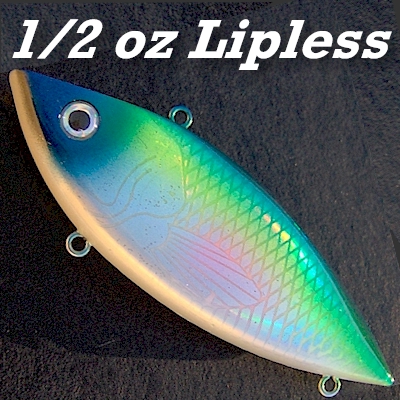
Perfect for fresh or saltwater
Weight: 1/2 oz (without hooks)
Body Length: 3-1/4 inches
Type: Hard Plastic. Lipless. Rattling. Sinking.
Diving Depth: Can be counted down to any depth.
Note: These lures come WITHOUT hooks or split rings.
These crankbaits are hard plastic, with a durable finish. They
rattle noisily and vibrate rapidly. They're made in America in
the same factory that models, molds and paints a number of the
hard plastic bait brands sold by various US tackle vendors.
Without any diving lip, the action of this lipless crankbait
comes mainly from the internal weighting and the angler-imparted
action. It has a very tight shudder or flutter, similar to the
tight-swimming body movements of shad, herring and sunfish. In
addition to its powerful vibrating swimming movement, this
lipless rattling crankbait also has a great shad or sunfish body
shape. The body shape also allows bass to easily mistake it for a
crayfish. In saltwater, it imitates bunker, menhaden, pogies,
butterfish, pinfish and many wide-bodied baitfish. It fits right
into the food chain.
It has a great swimming action when retrieved at any speed
from slow to medium to fast.
Horizontal Shimmying Fall
When paused, it sinks perfectly horizontal. It does not
nose-dive or spin or foul the line with the hooks when it sinks.
This is a common fault with other lipless crankbait brands - they
spin when they sink and foul your line - but this lipless
crankbait does not have that fault. It maintains a natural
horizontal body position on the fall. It maintains its natural
look and posture whenever paused and when allowed to deadfall
momentarily (a great strike trigger). Many other brands of
crankbaits do not do this well or at all, but this one does
About the Rattles
The internal chambers of this lipless rattling crankbait
contain many ball bearings that rattle noisily on the retrieve
and the sound resonates in the chambers. The internal chambers
also shift the rattles to the rear of the bait during the cast to
make for smooth, long and accurate casts.
The rattling noise made is moderate - not too loud yet not too
soft. The sound can best be described as a chatter, and it can be
heard rattling under water when the crankbait is still a good
distance away from a boat. Many persons wonder why rattling
lipless crankbaits work since they are so noisy? People feel the
loud rattling noise is unnatural - but that isn't true. Most
anglers do not know that the noise made by this lipless rattling
crankbait is quite close to the noise made by shad, herring,
sawbelly, blueback or alewife schools swimming tightly together.
Few anglers have ever heard the very loud wriggling, writhing
noise made by a school of such baitfish, but it is true. I have
heard the noise made by tightly swimming schools of shad
(herring, alewives, etc.) on occasion. The sounds of shad schools
can even be heard above the water when conditions are right. The
chatter of this lipless crankbait is remarkably similar to the
noise made by such schools. The noisy rattling made by this
lipless crankbait is a natural dinner bell for bass!
How to Use
No doubt you've used lipless crankbaits before, and you're
familiar with the common approach of chucking it out there,
withthe option to count it down to a specific depth, then winding
it in steadily. In addition, here are a few other, less common
yet productive tactics to try with this lipless crankbait:
- Drop Back Tactic. The genre of lipless crankbaits is
unique among hardbaits (topwaters, jerkbaits, crankbaits) because
it is the only hardbait category that's primarily a sinking
countdown bait. Not all lipless crankbaits are created equal when
it comes to this trait, however. Some brands sink way too quickly
and unnaturally to appeal to fish as they fall. Some brands
careen into a tailspin and foul your line when they sink. The
lures for sale here possess none of these faults found in some
other lipless brands.
The lipless crankbait here has a perfect horizontal fall and
flutters as it slowly sinks when paused. So where you may
countdown other brands simply as a means to get them deeper, you
can also let this one pause, slowly fall and flutter as a key
part of the presentation. This is especially powerful when you
miss a strike. Just stop, let it fall and flutter, or twitch it.
You may shake it like you shake a worm. Odds are high that you
will get another chance at a strike as you drop back this bait to
the bass that bit it or its buddy.
Also when bass follow the lure to boatside but do not strike,
simply let the lure drop and flutter all the way to bottom.
Chances are the bass will follow it down and pluck it off the
bottom. Just let it fall and let it hit bottom. Then wait for the
bite. If not, just raise and let it drop back to bottom a few
times. There's an excellent chance you can convert many missed
strikes or follow-ups into fish landed with this drop back
tactic.
Even when a fish follows another type of bait to the boat - a
topwater, jerkbait, floating crankbait, there's no way you can
throw one of those baits back on a following fish, but if you
keep this lipless crankbait tied on another rod, you can throw
this in where the follower was last seen (or in the direction it
was headed), and simply let it drop back to the bottom, popping
or shaking it every so often. Due to the perfect slow-falling,
fluttering action of this lure, you stand a great chance of
enticing fish that chased other baits to the boat.
- Use It Like a Jerkbait. Everyone who owns a
plastic-lipped, slender minnow-shaped jerkbait has caught fish
ripping or jerking and then pausing it. However this retrieval
tactic is not used when it comes to lipless crankbaits. The
problem is, ripping or jerking and pausing a lipless crankbait
won't work with many other lipless bait brands since they twist
and spin and foul the line when ripped and paused, and don't
suspend horizontally. However, the slow-sinking crankbait for
sale here behaves beautifully when you use it just like a
jerkbait.
You can rip or jerk and pause any of the colors for sale here.
However, my favorite colors for this tactic tend to be the
reflective white pearl or hologram finishes. Reason is, when a
pearl-bellied or hologram pattern flips and flashes its bright
sides when twitched, ripped or jerked, that sudden flash is often
what drives fish wild - when the lipless crankbait flashes its
belly and sides at fish.
A nice way to visualize this tactic as you are doing it, is to
think of the flat-sided bait rattling and vibrating along, trying
to keep its bright belly and sides hidden (the typical "dark
back light belly" camouflage effect). Now when you rip or
jerk it, think of that like flipping the lights on in a dark
room. Any following fish get a sudden flash of reflective sides
and belly. Then pause, which is when you get bit. It is an
irregular action that works so well because bass have not seen
such flipping/flashing action at all in a crankbait. Yet baitfish
do it all the time, especially shad and herring flip on their
sides constantly.
No one ever said fishing is rocket science, but it truly is an
art. Try retrieves using long slow jerks or short sharp snaps -
and everything in between. This is one of the few lipless
rattlebaits you can use like a jerkbait. Yet unlike long, slender
jerkbaits, it has the perfect shape, deep-bodied profile and
natural flipping action of shad.
- Pendulum Fall. When bass are suspended or simply
schooling over structure (points, channels, ledges, etc.),
I'll tend to position the boat over a high spot or over the
shallowest spot, and cast toward deeper, open water. Then simply
let the lipless crankbait pendulum fall in toward me. The key is
how far to let the crankbait sink at first. When I let it get
down to where I think the fish are, I'll give the crankbait one
flip. This is an attention-getter. It signals something is not
quite right. It's just like a shad in trouble that flips up on
its side, making an attempt to right itself. I then let it fall
again and give it two flips. Then let it pendulum fall in toward
me again. All the while it is coming back to me in a pendulum
arc, and give it three more flips. Just pop it quick, to give it
a short, erratic, struggling movement. It moves at most one foot
when you flip it. It's just an attention-getter that shows bass
something is not right. I basically let the crankbait swing back
in to me, through the fish, above the cover, over the structure,
and pop it once, twice or three times. On its way back in, as the
bottom becomes shallower, it's advantageous if the crankbait
bumps into brush or anything else as it gets closer in and closer
to the bottom. That obstacle impact is a great strike trigger.
More often than not, the crankbait will get nipped as it bounces
off anything in its path. Once it reaches bottom, yoyo it up and
down as you reel it in the rest of the way back to the boat.
- Don't Forget to Bluff. Along bluff walls, simply move
the boat in close, cast horizontal to the bluff, engage the reel
and allow the crankbait to freefall down the sheer face. Just
give it a pop or you can gently shake it like you would shake a
worm, as it falls along the bluff face, making it rattle, and
picking up suspended bass as it shakes and sinks in an arc back
to and under the boat. This is a great mid-summer tactic, and the
most productive bluffs often have slivers of shade close to the
wall where bass suspend and wait in the shade.
Hooks to Use
Note: These lures come WITHOUT hooks
or split rings.
Many anglers tend to have extra treble hooks and split rings.
And many anglers prefer their own certain hook model to replace
whatever hooks come stock on a lure anyway. That's why I offer
you these crankbaits without any hooks or split rings. You'll
need to provide your own treble hooks (two) and split rings
(three) for this lure. There are three popular hook
configurations for this lure:
- #4 Belly; #6 Tail. There are many different brands of
lipless crankbaits of this size (3 inches) and weight (1/2 oz).
Most brands tend to come with a #6 tail treble and #4 belly
treble. These are the most popular factory-installed hook sizes
across many brands. If you desire to go with this configuration
(#6 tail; #4 belly), I suggest the Mustad Triple Grip trebles.
The Mustad Triple Grip lives up to its name. The uniquely-angled
hook points to grip bass very well. Also, the Mustad Triple Grips
have long shanks that keep the hooks further away from the bait,
exposing them better when fish bite. This specific pairing of
Mustad Triple Grip hooks will not marry or tangle each other too
often with a #6 tail and #4 belly.
- #4 Belly; #4 Tail. Many anglers feel that a lure
manufacturer has some sort of optimum action or perfect balance
in mind when the manufacturer puts specific hooks on a bait. To
the contrary, I have not found it to matter nor anything
"magic" about the factory-installed hook sizes on many
crankbaits. For bass fishing with baitcasting gear, and going for
better-than-average bass such as in tournament competition, I
prefer to upsize the tail treble on lipless crankbaits to a size
#4. Most manufacturers install a #6 on the tail, but I have yet
found a single bass that somehow favored a smaller, weaker #6
versus a larger, stronger #4 tail treble. Upgrading to the #4 on
the tail helps hook and land more and better bass.
- #2 Belly; #4 Tail. Anglers in Florida, Mexico, Texas
(for example), or many other lakes and regions where big bass are
common, often opt for even bigger hooks on this bait, upgrading
the belly treble to a #2. The bigger hooks tend not to detract
from the lure action or number of strikes you get, and will hook
and hold bigger bass. The weak link in this set-up can become the
figure eight hook hanger molded into the crankbait body. A bigger
bass (and use of heavy tackle, especially braided lines) may or
may not affect the #2 belly treble hook itself, but pressure of a
big bass on heavy braided line can also twist or pull the hook
hanger out of the lure body. Nevertheless, the benefits of a
larger #2 belly treble still outweigh the risks, and most anglers
who upgrade to a #2 belly and #4 tail treble should not normally
experience problems.

Natural Shad
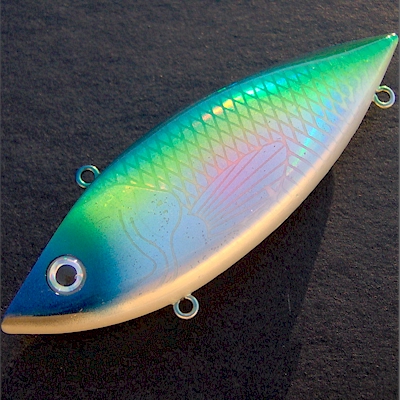
Real Shad Hologram
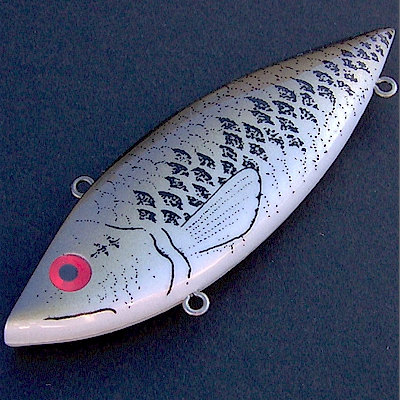
Red Eye Bass
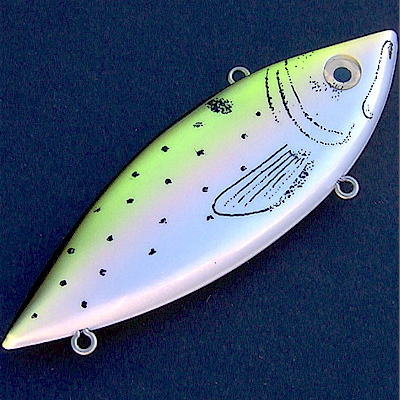
Alewife
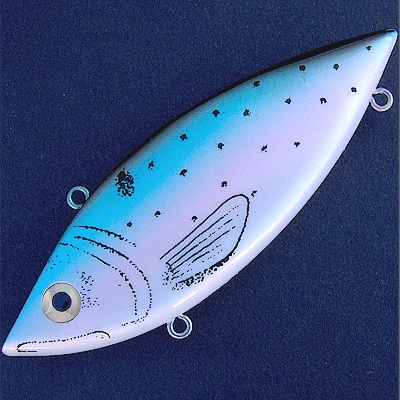
Blue Herring
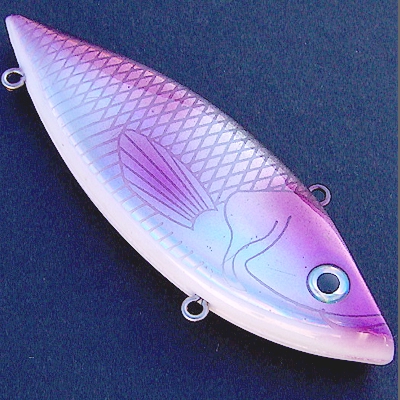
Purple Shimmer
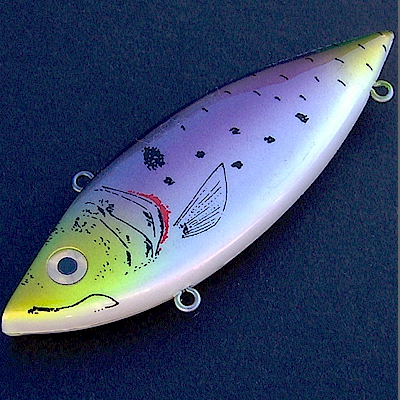
Junebug Yellow
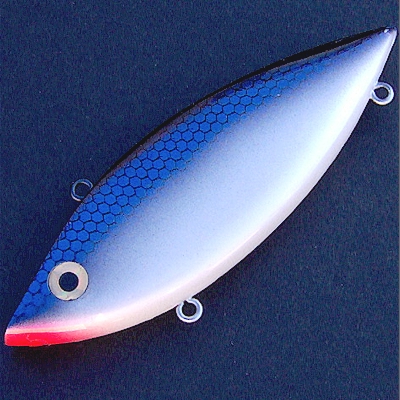
Smokey Joe
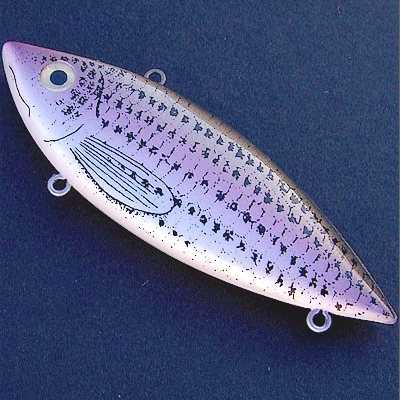
Hickory Shad
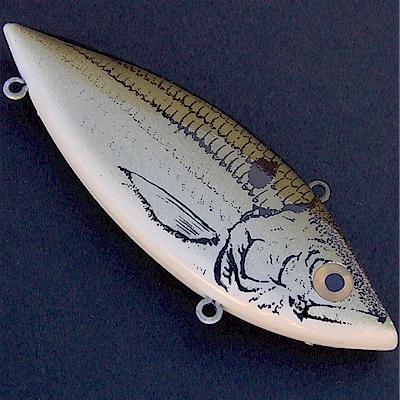
Olive Shad
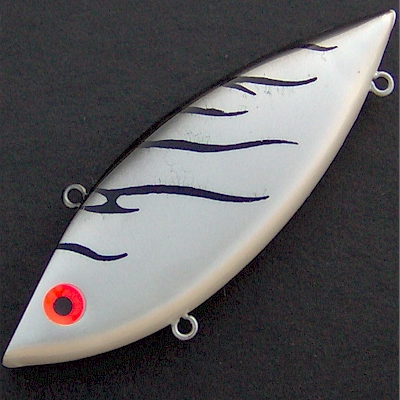
White Tiger
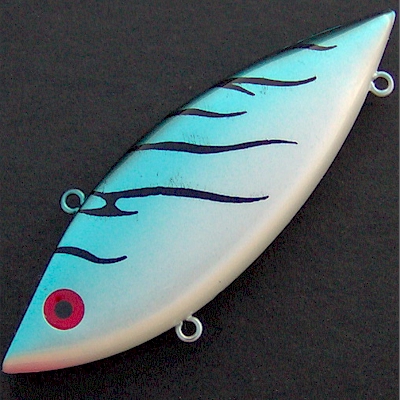
Blue Tiger

Pale Green Tiger
3/4 oz Lipless Rattling Crankbaits ~ No Hooks
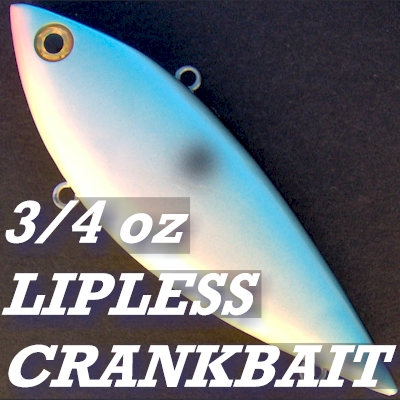
Perfect for fresh or saltwater
Weight: 3/4 oz (without hooks)
Body Length: 4 inches
Type: Hard Plastic. Lipless. Rattling. Sinking.
Diving Depth: Can be counted down to any depth.
Note: These lures come WITHOUT hooks or split rings.
These crankbaits are hard plastic, with a durable finish. They
rattle noisily and vibrate rapidly. They're made in America in
the same factory that models, molds and paints a number of the
hard plastic bait brands sold by various US tackle vendors.
Without any diving lip, the action of this lipless crankbait
comes mainly from the internal weighting and the angler-imparted
action. It has a very tight shudder or flutter, similar to the
tight-swimming body movements of shad, herring and sunfish. In
addition to its powerful vibrating swimming movement, this
lipless rattling crankbait also has a great shad or sunfish body
shape. In saltwater, it imitates bunker, menhaden, pogies,
butterfish, pinfish and many wide-bodied baitfish. It fits right
into the food chain.
It has a great swimming action when retrieved at any speed
from slow to medium to fast.
Horizontal Shimmying Fall
When paused, it sinks perfectly horizontal. It does not
nose-dive or spin or foul the line with the hooks when it sinks.
This is a common fault with other lipless crankbait brands - they
spin when they sink and foul your line - but this lipless
crankbait does not have that fault. It maintains a natural
horizontal body position on the fall. It maintains its natural
look and posture whenever paused and when allowed to deadfall
momentarily (a great strike trigger). Many other brands of
crankbaits do not do this well or at all, but this one does.
In fact it shimmies so much as it slowly sinks that it rattles
all by itself even when the angler is doing nothing, just from
shimmying on the drop. When bass can be spotted following the
bait (or even blindly in the middle of a retrieve), simply stop
reeling and the built-in shake and rattle as the lure simply
drops can be more than trailing bass can stand.
The way this crankbait shimmies and shakes as it falls when
paused, you will not find this kind of action in any other large
lipless crankbait. There's no other large lipless crankbait quite
like it.
About the Rattles
The internal chambers of this lipless rattling crankbait
contain many ball bearings that rattle noisily on the retrieve
and the sound resonates in the chambers. The internal chambers
also shift the rattles to the rear of the bait during the cast to
make for smooth, long and accurate casts.
The rattling noise made is moderate - not too loud yet not too
soft. The sound can best be described as a chatter, and it can be
heard rattling under water when the crankbait is still a good
distance away from a boat. Many persons wonder why rattling
lipless crankbaits work since they are so noisy? People feel the
loud rattling noise is unnatural - but that isn't true. Most
anglers do not know that the noise made by this lipless rattling
crankbait is quite close to the noise made by shad, herring,
sawbelly, blueback or alewife schools swimming tightly together.
Few anglers have ever heard the very loud wriggling, writhing
noise made by a school of such baitfish, but it is true. I have
heard the noise made by tightly swimming schools of shad
(herring, alewives, etc.) on occasion. The sounds of shad schools
can even be heard above the water when conditions are right. The
chatter of this lipless crankbait is remarkably similar to the
noise made by such schools. The noisy rattling made by this
lipless crankbait is a natural dinner bell for bass!
At 4 inches long, the bigger size of
this rattling crankbait catches a bigger size of bass. Please
enjoy!
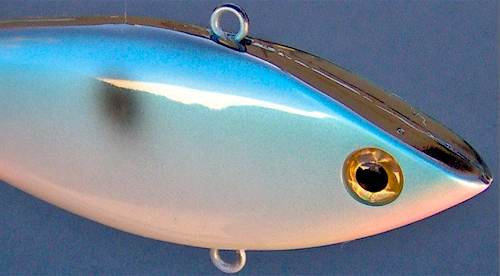

3/4 oz Lipless Crankbait ~ Blueback Herring ~ No Hooks

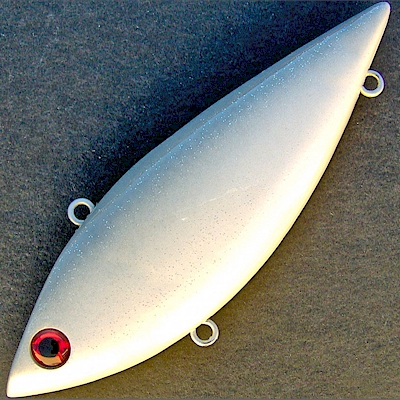
3/4 oz Lipless Crankbait ~ Silver Shiner ~ No Hooks
These lipless rattling crankbaits are just about palm-sized.
Threadfin shad color shown here.
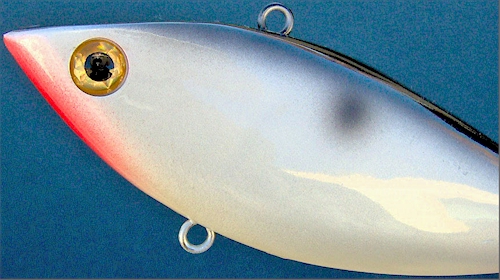
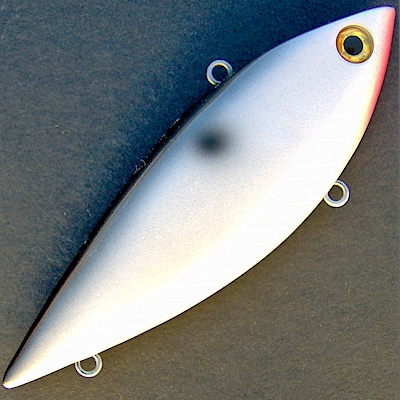
3/4 oz Lipless Crankbait ~ Black White Pearl ~ No Hooks
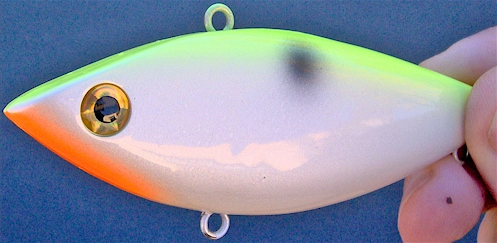
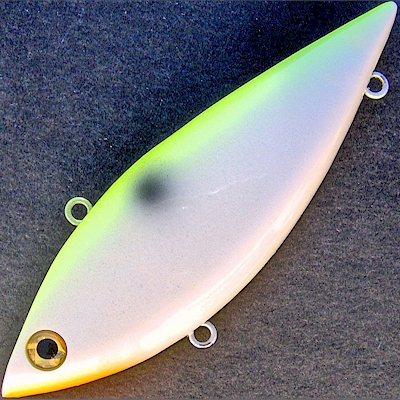
3/4 oz Lipless Crankbait ~ Chartreuse White Pearl ~ No Hooks
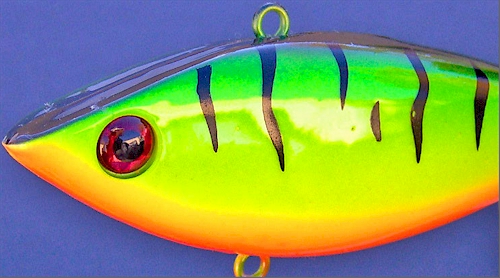
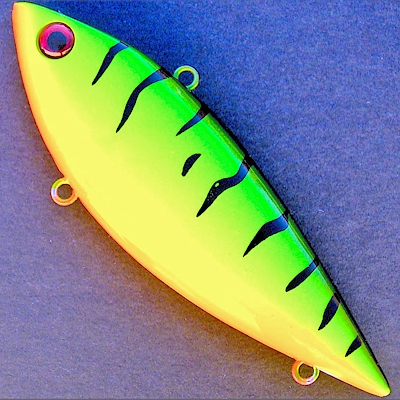
3/4 oz Lipless Crankbait ~ Fire Tiger ~ No Hooks
The fire tiger rattle bait is one of the very best colors and
lures (due to the rattles) to use in stained or dirty water.
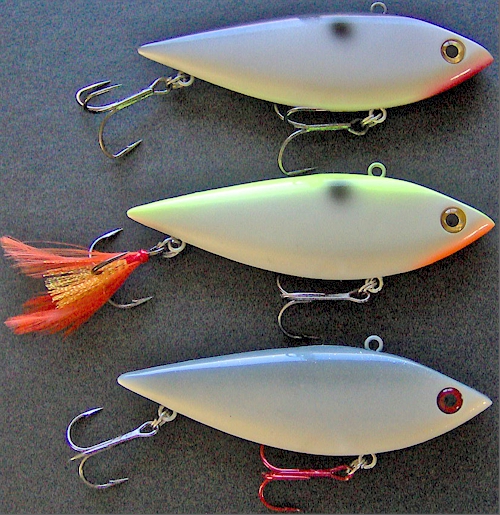
Note: These lures come WITHOUT hooks
or split rings.
A surefire way to rig these is with size #2 hooks. I am often
asked if red hooks matter or make a difference in any way. After
many years of looking for and trying to detect a difference,
honestly I cannot notice that red hooks make a difference in any
way. If red hooks give one a sense of confidence or add artistic
flair to a bait, that's cool. However, I don't think anyone can
say for certain that red hooks get more bites or not. A similar
situation is that some crankbaits have red splashes under the
mouth and some don't. It's not possible to say whether the
presence or absence of a red chin splash (or red hook) influences
more bites.
When it comes to feather trebles, however, it seems as if I
have seen frequent occasions especially during cold weather/water
seasons or cold front days when bass would not hit crankbaits
very hard or solidly - until a feather treble was added to the
tail. A feather tail can make the difference some days between a
lot of missed bumps that may be converted to solid takes with a
feather treble.

Note: These lure bodies come WITHOUT hooks or split rings.
|
